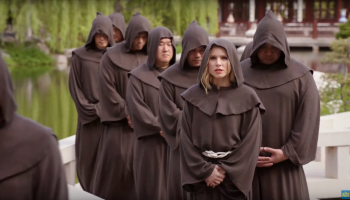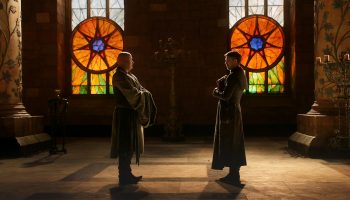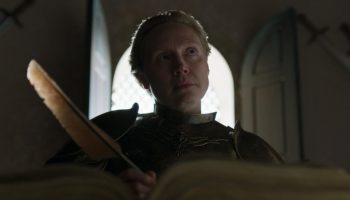Review: The Green Knight
Director: David Lowery
Runtime: 130 minutes
Rating: R(US)/15(UK)/MA15+(Aus)
Cast: Dev Patel, Alicia Vikander, Joel Edgerton, Sarita Choudhury
Release: July 30, 2021 (theatres); available via streaming now.
In a wide angled shot of an empty hall, a man sits upon a throne. He holds a sceptre and orb—symbols of Western royal power since the Middle Ages. He is bathed in bright light, a crown suspended in the air above his head. A lilting and ominous lyrical voice-over, reminiscent of Galadriel in the opening scenes of The Fellowship of the Ring, speaks of a great King, King Arthur, while the camera zooms in; the scene becomes warmer as we get closer, from the golden robes this king wears, to his calm regal presence, until suddenly, unexpectedly, he is engulfed in flames. As he burns, the voice-over hisses: ‘This is not that king, nor is it his son.’
So begins The Green Knight, a highly anticipated and wonderfully unsettling film released last month by A24. Director David Lowery, who directed the charming live-action remake of Disney’s Pete’s Dragon, creates an entirely different mood in The Green Knight. In it, he interrogates the bleak relationship between the stuff of legend and what—and who—is left behind in the making of those legends. As with most medievalist films, although The Green Knight is set in the Middle Ages, it uses the medieval past to hold a mirror up to the present.
As Gawain begins a hero’s journey in a conquered land, I found myself immediately reminded of the devastating effects of imperialism and tribalism in the wake of situations like what is currently unfolding in Afghanistan. This film begins with a sense of disruption, of anxiety and dread, and this discomfort that the audience feels is an echo of the disruption of nation and national identity that grips a post-conflict society.
Medievalism and Conflict
Films set in the Middle Ages like The Green Knight are filtered through centuries of other post-medieval depictions of the Middle Ages (i.e., ‘medievalisms’), a phenomenon that scholar Amy Kaufman refers to as ‘medievalism doubling back on itself.’ When the medieval is copied and recopied ad infinitum, one of the themes that remains consistent is the idea that the Middle Ages were a particularly grim ‘Dark Ages.’ There is a common public (mis)perception that the Middle Ages were a dark time, a violent time, and one of little intellectual achievement. The Middle Ages are wrongly imagined as a thousand years of war.
Thus, war lies at the heart of many post-medieval depictions of the Middle Ages: from Shakespeare’s Macbeth and Richard III, to HBO’s enormously popular Game of Thrones (2011–2019). In all of these, a fictionalized Middle Ages serves as a canvas for exploring contemporary conflicts. The Green Knight provides the perfect stage for anxieties about the results of the 21st century’s conflicts to play themselves out in the safety of the distant past.
The Once and Future King
You have heard the story of Arthur. The young prince, hidden away to protect him from usurpers. The legend that only the ‘true king’ can lift the enchanted sword from a stone to unite a Britain ravaged by war. The formation of the worthy and legendary council of Camelot. The devastating fall of Camelot. And the promise of Camelot returning.
For the most part, fidelity to an original text is not very important in works of medievalism. But, we do expect certain things to happen, and those things often do. For example, in general, King Arthur is always a hero. In Guy Ritchie’s King Arthur: Legend of the Sword (2017), the filmmakers knit together a rollicking mish-mash of Arthurian stories to create a medieval heist film. But Arthur is still the hero. He’s flawed, perhaps. He’s still on his hero’s journey. But he is a hero nonetheless.
Cinematic adaptations of the King Arthur story are particularly concerned with Arthur’s position as the “once and future king” (as he is famously called). This is true even when the plot is focused on something else, such as the quest for the Holy Grail, or the love triangle between Arthur, Guinevere, and Lancelot. The promise of Arthur’s return is always in the background. Each film adaptation of King Arthur exhibits various anxieties and concerns. But all of them tend to end with the hope of a Camelot restored to its glory years.
Medievalism references itself to create a set of expectations. Arthur is the hero, no matter the context. He is the ‘once and future king,’ no matter what else is going on.
The Green Knight takes a significantly different approach. In this film, we see the aftermath of conquest, the discomfiting effect this has on a king and his country, and experience the fatigue of a people who have lost faith in those in positions of authority.
Gawain and the Grey Court
From its unsettling opening sequence of Gawain catching fire, the film cuts to a small farmstead with livestock milling around, the brays and clucks made eerie by a muted colour scheme. Off to the side, not immediately noticed, a man is hunched against a hut. Sleeping, perhaps. The scene continues, and the man’s lack of movement, combined with the ordinary sounds of a farm, begins to feel uncomfortable. The animals become agitated. The man remains slumped. There is shouting off screen, but the man does not move. A woman runs up and mounts a horse, and another man leads her away, drawing his sword. Metal scrapes against metal off screen and the shouts become urgent. Yet the man remains still.
The camera withdraws at this point of imminent violence, retreating through a stone window into a brothel, and to the sleeping figure of Gawain (played by Dev Patel) who is roused by his lover Essel (Alicia Vikander) to attend mass. While they are on the way to church, the playful harmony of Gawain and Essel shields the audience from violence. We are no longer focusing on people who are displaced, people dead amongst their livestock, people dying in the streets. These aftershocks of conquest are erased by the blossoming of a sweet romance.
Later, when Gawain rides away from the city of Camelot, the barren ruinous landscape displays the scars of conquest. These are barely noteworthy, and certainly not remarked upon by Gawain. He stops briefly to look at a dead man hanging from a cage at the crossroads. He looks impassively at a dead soldier in the woods. And he barely acknowledges a battlefield of recently dead men, talking instead to a boy (Barry Keoghan) scavenging from their bodies. The boy is looking for his brothers.

This is the land that the great King is referring to when he gives his Christmas speech at the beginning of the film, before the arrival of the Green Knight.
Out my window this morn, I looked and I saw a land shaped by your hands. You have lain those same hands on your Saxon brethren, who now in your shadow bow their heads like babes. Peace. Peace you brought to your kingdom.
The peace, however, came at the cost of all those bodies. The question of cost is rather important here. When asked for payment for directions, Gawain reluctantly throws the scavenger from the killing fields a coin, which the boy later angrily declares is ‘not enough.’ The money, we are told, is insufficient. It cannot erase what has happened to his family, his country, his life.
An Insecure Regime

It is important to note the appearance of King Arthur and Queen Guinevere (played by Sean Harris and Kate Dickie) in this film. They are old. Far from the young, vibrant court of legend – and of the original poem for that matter – the knights around the round table are grey, and the figureheads of this administration are aged. This is especially important when we realise how young this regime is. The unnamed hall, while expansive, is still being constructed, as displayed by the scaffolding outside. Arthur also reveals that they have no children, which indicates that this newly established government has no plans for the future. Even more striking is that, though we know through the poem this film was based on and through context that they are King Arthur and Queen Guinevere, the film never names them.
Alongside the instability, there is a lamentation of war built into the film. The Queen asks Gawain to look at the people in the room, to say what he sees. Gawain says: ‘I see legends.’ Yet, even while noting that the knights have ‘spilled enough blood’ for the King, when the Green Knight bursts into the hall and challenges these legends, no one stands up. None of them even offers a weapon when Gawain answers the challenge without a sword. This show of passivity highlights the empty valorisation of knights and chivalry in this film. War, it is saying, is not glorious, it is empty and promotes people to an undeserved status.
This lamentation is made clear during Gawain’s journey later in the film, when he is given refuge in the home of an unnamed Lord and Lady. The Lady (also played by Alicia Vikander), observes of the Green Knight’s colouring,
While we are all off looking for red, in comes green. Red is the colour of lust, but green is what lust leaves behind. In heart. In womb. Green is what is left when ardour fades, when passion dies, when we die too. Where you go, grass will fill your footsteps. Moss will cover your tombstone, and as the sun rises, green will spread over all, in all its shades and hues. This Verdigris will overtake your swords and your coins and your battlements, and, try as you might, all you hold dear will succumb to it. Your skin, your bones, your virtue.
While she talks about green being the colour of rot, death, decay, it is steeped in the language of empires: swords, coins, battlements. The creation of kingdoms and empires breeds death, and these kingdoms and empires are themselves doomed to die.
Why a Knight Does What He Does

Where most stories of Camelot brush past the human toll of empire-building, The Green Knight is unflinching, pressing deeply into the pain of colonisation. The Lord (Joel Edgerton), sits amiably with Gawain and asks why he is going on his quest. Gawain replies that his motivation is ‘Honour’ and that ‘that is why a knight does what he does.’ The Green Knight questions the cost at which such accolades are earned. Two thirds of the way through the film, Gawain is given a green sash that is supposed to protect him from all harm. But the green sash ultimately does not work as protection; Gawain indeed loses his head. It is simply military decoration, an emblem of life and death. It was gained through sin and is a mockery of honour.
In this film, Gawain’s hero’s journey highlights the effects of imperialism. Despite all the loss and devastation he witnesses, despite the killing fields he encounters, despite all the horrors he sees, he continues on his path of empire-building. Because it is simply what knights do. It is hard to watch this play out and not think about the conflicts in the Gulf, the pursuit of empires there, the dismissal of the human toll in these strategies. Because it is what empires do.





